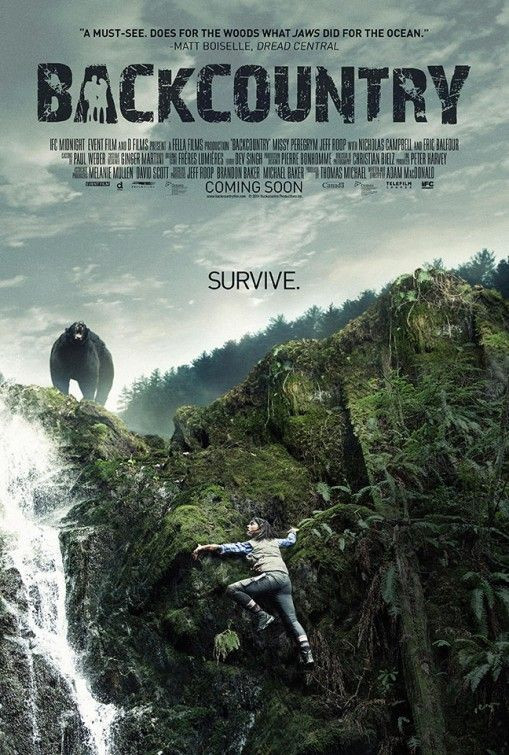Few subgenres of horror film have been so neglected as the bear movie. Even the genre’s classic, 1979’s Prophecy, relies on mutant monsters and a fleshy lump of camp. The release of Backcountry on March 20 is the first time bear horror has ever succeeded with a straight face. Most remarkably, Backcountry sheds the standard monstrous grizzly bear found in subgenre staples like Grizzly and Grizzly Park, preferring the humble black bear.
iDigitalTimes sat down with Adam MacDonald, the director of Backcountry, to talk about the untapped horror potential of the American black bear.
Backcountry Trailer
MacDonald had originally settled on a black bear as his Backcountry killer because it hadn’t been done before.
“There’s never been a black bear attack movie, ever. Ever," he said. "So I wanted to be the first and do it in a way that makes you feel like it’s really happening. It’s not a marauding bear. It’s not a bear that can flip over a car. It’s just the real deal.”
While the first motive was novelty, MacDonald quickly realized the black bear was more ferocious than its more timid reputation would suggest.
“Black bears are as ferocious, and have killed as many people if not more [than grizzlies]. They’re a serious contender," MacDonald said.
Black Bears are Killers
While the black bear is usually considered the less dangerous counterpart to the predatory grizzly, kodiak or polar bear, the body count isn’t as disparate as most would imagine. In fact, black bears have proven exactly as deadly as the grizzly bear in recent years, with both claiming 22 victims since 2000. This didn’t come as a surprise to Backcountry's director.
“Being in Canada we’ve got some pretty good stories and true accounts that it does happen,” he said.
When it comes to talking about man-eating predators, it’s worth noting that bear attacks are exceedingly rare. Bear Attack: Their Causes and Avoidance by Stephen Herrero is considered the definitive take on the subject. And while Herrero warns against becoming “estranged from nature because of fear of the unknown regarding bears,” his cautionary note comes right before this chilling story:
“At about 2:15 p.m. the men heard a crashing in the brush and then saw a bear very close and charging at them. The men shouted to the boys to run and then ran themselves. In their excitement each of the men rain in a different direction. The bear ran after Muskett, who got only about twenty feet before he fell down. The bear stopped, stood on its hind legs, looked at Muskett, but didn’t injure him. The bear then quickly dropped onto four legs and ran after and attack Cohoe, who was still running. Within seconds the huge bear clasped its powerful jaws around Cohoe’s face and bit. Cohoe screamed and within a minute or two the bear attacked twice more. Late the next morning an investigative team at the mauling site found fishing gear and the upper part of Cohoe’s jaw and mouth with nine teeth, his nose, and a large piece of his cheek. About a week later Cohoe died from his injuries.”
Like with sharks, the rarity of the attacks does little to dull the real-world horror possible when people become prey.
“Something switches off in their brain and they become predatory… and that really shook me,” MacDonald said.
Lest it appear that MacDonald is just trying to drum up terror for his Backcountry killer, research seems to back up his depiction. Herrero explains that black bears exhibit two types of behavior before an attack, “defensive and predatory,” but it’s the rarer predatory behavior that cause “most serious or fatal attacks by black bears.”

Black Bears are Everywhere... Not Just in the Backcountry
Maybe the best reason to deploy the black bear as the horror movie totem of Backcountry is its remarkable ubiquity. There are at least 600,000 black bears in North America, with bears found in every province of Canada, 40 U.S. states, and even some mountainous regions of Mexico.
“Black bears are everywhere. It affects more people that way. You’re camping in Florida… there’s black bears down there," MacDonald said. "They’re everywhere.”
While the woods may be statistically safe, the visceral truth of the rare black bear attacks makes its rarity in horror movies surprising. The great power of Backcountry is in capturing that one horrifying moment where people are transformed from a collection of hopes, neuroses and relations into raw meat. For all the campy goodness of Grizzly, it’s Backcountry that captures the gripping specificity to be found in the black bear’s predations. MacDonald described his hopes for the instinctual fears Backcountry could bring out in its viewers:
“When the bear attack happens you’re in it with them," he said. "You’re not watching it. You’re in it.”
Backcountry is out now in theaters and VOD.


















